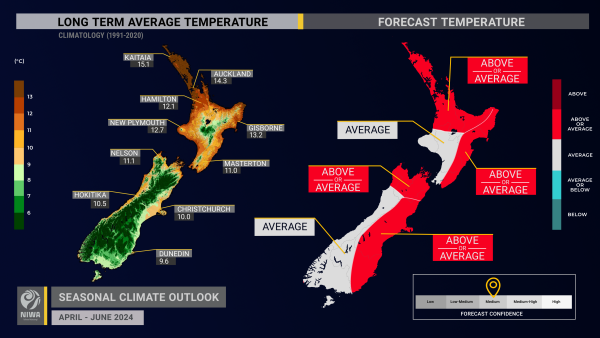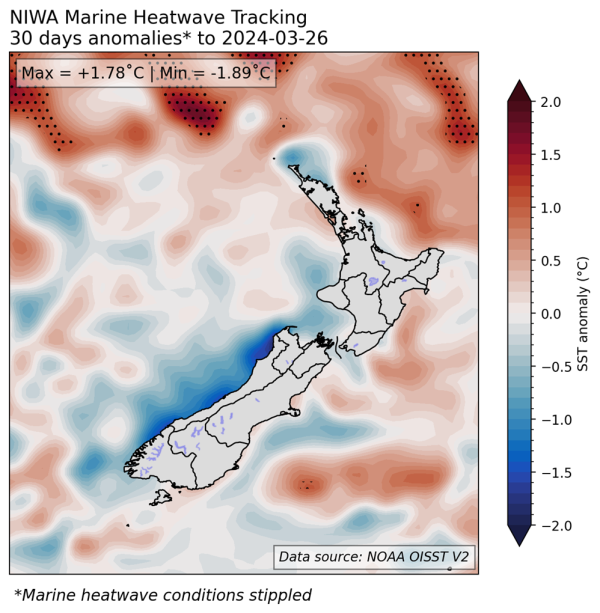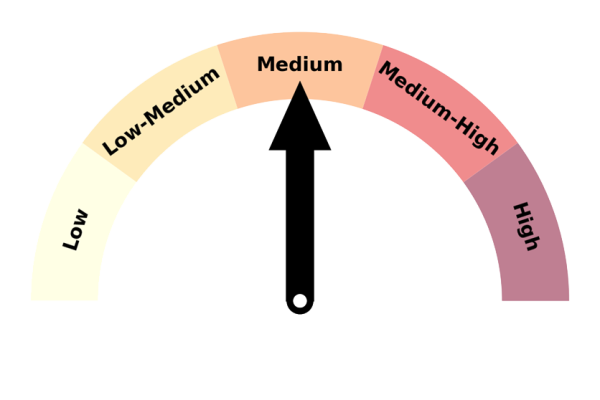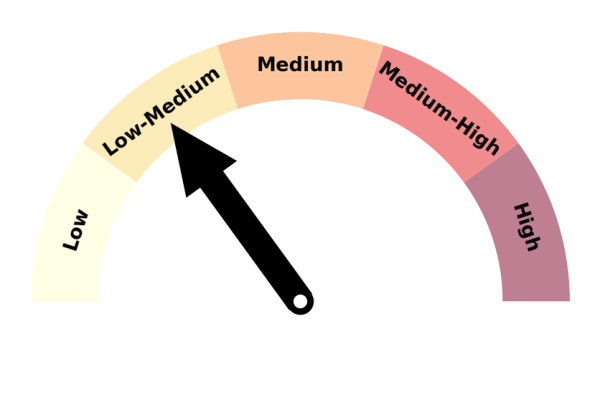Outlook summary
- El Niño is expected to ease to ENSO neutral by June.
- Air pressure is expected to be higher than normal in the New Zealand region, particularly near the North Island. This will most likely come with more westerly winds than normal, sometimes strong, reflective of El Niño’s continued but waning influence.
- Rainfall is most likely to be near normal in the west of the North Island, about equally likely to be near normal or above normal in the west of the South Island, and about equally likely to be near normal or below normal in all remaining regions. Monitor NIWA35 for updates.
- Early April is forecast to be drier than normal before rainfall chances increase mid-month.
- Temperatures are most likely to be near average in the west of both islands and about equally likely to be near average or above average in all remaining regions.
- An increased frequency of southwesterly winds will see chilly air masses affect New Zealand at times. The prevalence of high pressure may also generate prime conditions for radiational cooling, contributing to frosty nights and mornings.
- Coastal sea surface temperatures (SSTs) ranged from 0.70˚C below average to 0.08˚C above average during March.
- Soil moisture levels are most likely to be near normal in the west of both islands and most likely to be below normal in all remaining regions.
- River flows are most likely to be near normal in the west of both islands, equally likely to be near normal or below normal in the east of the North Island, and most likely to be below normal in all remaining regions.
Regional predictions for April – June 2024
The tables below show the probabilities (or percent chances) for each of three categories: above average, near average, and below average. In the absence of any forecast guidance there would be an equal likelihood (33% chance) of the outcome for any of the three categories. Forecast information from local and global guidance models is used to indicate the deviation from equal chance that is expected for the coming three-month period. All outlooks are for the three months as a whole. There will inevitably be relatively wet and dry days, and hot and cold days, within a season. The exact range in temperature and rainfall within each of the three categories varies with location and season. However, as a guide, the “near average” or middle category for the temperature predictions includes deviations up to ±0.5°C for the long-term mean, whereas for rainfall the “near normal” category lies between 80 per cent and 120 per cent of the long-term (1991-2020) mean.
Northland, Auckland, Waikato, Bay of Plenty
- Soil moisture levels and river flows are most likely to be below normal (50% chance).
| Temperature | Rainfall | Soil moisture | River flows | |
| Above average | 45 | 25 | 10 | 10 |
| Near average | 40 | 35 | 40 | 40 |
| Below average | 15 | 40 | 50 | 50 |
Central North Island, Taranaki, Whanganui, Manawatu, Wellington
Probabilities are assigned in three categories: above average, near average, and below average.
- Temperatures are most likely to be near average (45% chance each).
- Rainfall totals are most likely to be near normal (45% chance). Early April is forecast to be drier than normal before rainfall chances increase in the second half of the month.
- Soil moisture levels and river flows are most likely to be below normal (50% chance).
| Temperature | Rainfall | Soil moisture | River flows | |
| Above average | 35 | 25 | 10 | 20 |
| Near average | 45 | 45 | 40 | 30 |
| Below average | 20 | 30 | 50 | 50 |
Gisborne, Hawke’s Bay, Wairarapa
Probabilities are assigned in three categories: above average, near average, and below average.
- Temperatures are about equally likely to above average (45% chance) or near average (40% chance).
- Rainfall totals are about equally likely to be below normal (40% chance) or near normal (35% chance). Early April is forecast to be drier than normal before rainfall chances increase mid-month.
- Soil moisture levels are most likely to be below normal (50% chance) while river flows are equally likely to be near normal or below normal (45% chance each).
| Temperature | Rainfall | Soil moisture | River flows | |
| Above average | 45 | 25 | 10 | 10 |
| Near average | 40 | 35 | 40 | 45 |
| Below average | 15 | 40 | 50 | 45 |
Tasman, Nelson, Marlborough, Buller
Probabilities are assigned in three categories: above average, near average, and below average.
- Temperatures are equally likely to near average or above average (40% chance each).
- Rainfall totals are about equally likely to be near normal (40% chance) or below normal (35% chance). Early April is forecast to be drier than normal before rainfall chances increase mid-month.
- Soil moisture levels and river flows are most likely to be below normal (50% chance).
| Temperature | Rainfall | Soil moisture | River flows | |
| Above average | 40 | 25 | 10 | 10 |
| Near average | 40 | 40 | 40 | 40 |
| Below average | 20 | 35 | 50 | 50 |
West Coast, Southern Alps and foothills, inland Otago, Southland
Probabilities are assigned in three categories: above average, near average, and below average.
- Temperatures are most likely to be near average (45% chance).
- Rainfall totals are about equally likely to be near normal (40% chance) or above normal (35% chance). The region will likely be exposed to strong fronts and lows on occasion.
- Hydro lake inflows during March were below normal at Te Anau, Clutha, and Waitaki (lowest March inflows on record since at least 1926). A more unsettled weather regime may arrive during mid-to-late April.
- Soil moisture levels and river flows are most likely to be near normal (40-50% chance).
| Temperature | Rainfall | Soil moisture | River flows | |
| Above average | 35 | 35 | 20 | 30 |
| Near average | 45 | 40 | 50 | 40 |
| Below average | 20 | 25 | 30 | 30 |
Coastal Canterbury and the nearby plains, east Otago
Probabilities are assigned in three categories: above average, near average, and below average.
- Temperatures are equally likely to near average or above average (40% chance each).
- Rainfall totals are about equally likely to be near normal (40% chance) or below normal (35% chance). Early April is forecast to be drier than normal.
- Soil moisture levels and river flows are most likely to be below normal (50% chance).
The full probability breakdown is:
| Temperature | Rainfall | Soil moisture | River flows | |
| Above average | 40 | 25 | 10 | 10 |
| Near average | 40 | 40 | 40 | 40 |
| Below average | 20 | 35 | 50 | 50 |
Background
TheNINO3.4 Index anomaly (which covers the west-central equatorial Pacific) over the last month (through 26 March 2024) was +1.31˚C, remaining in the El Niño range. Oceanic El Niño has weakened by about 0.5˚C since January.
The Southern Oscillation Index (SOI) was in the neutral range during March (+0.4) and January-March (-0.1).
Of the models monitored by NIWA, ENSO neutral conditions are favoured to develop by June. La Niña conditions are then favoured to develop between July and September.
Trade wind strengthwas well above normal near and west of the International Date Line during March. This generated an upwelling Kelvin Wave in the west-central equatorial Pacific, which should see cooler than average sub-surface ocean water move across the Pacific over the next two months. Enhanced trade winds are forecast to continue near the International Date Line during April, which should result in additional oceanic cooling.
At the end of March, the subsurface equatorial Pacific was cooler than average across most of the basin below 100 m depth, with below average temperatures moving closer to the surface in the east during March. Notably, subsurface waters were 3˚C to 5˚C below average in the east, lending credence to the eventual development of La Niña later this year.
During March, convective forcing favoured the western Pacific with subsidence over the eastern Pacific and South America, a La Niña-like pattern. This was linked to a strong, early-month pulse of the Madden-Julian Oscillation (MJO). By late March, the pulse had propagated into the eastern Pacific, generating an El Niño-like response. Such variability is to be expected from an ocean-atmosphere system that is transitioning toward an ENSO-neutral state.
Historically, MJO activity in the western Pacific resulted in an increased chance for above normal rainfall in New Zealand, but no such pattern eventuated during March. This may have owed to the speed of the MJO pulse or the fact that the background state of the climate system still favoured El Niño.
During early April, the MJO is forecast to track across the Indian Ocean while weakening. This has historically resulted in more high pressure around New Zealand and drier than normal conditions for many regions. Convective forcing may weakly favour the Maritime Continent and Pacific Ocean during mid-to-late April, seeing the chances for rain increase around New Zealand. However, a similar progression during March did not result in meaningful rainfall. Temperatures during the first half of April don’t look persistently below average either, a change from March.
May and June favour enhanced convection over the Atlantic Ocean, Africa, and the western Indian Ocean – patterns that have historically favoured southwesterly winds across New Zealand as well as drier than normal conditions in northern and eastern areas of both islands. Strongly suppressed convection is signalled over the eastern Maritime Continent and western Pacific, which may reduce the chance for moisture-laden low pressure systems to affect New Zealand from the north.
Climate-sensitive sectors are encouraged to make use of the New Zealand drought dashboard, which provides 35-day outlooks of rainfall and drought, updated once daily: https://niwa.co.nz/climate/seasonal-climate-outlook
The Southern Annular Mode (SAM) was highly variable during March. This variability is expected to continue in the season ahead.
Sea surface temperatures in New Zealand’s coastal waters were near average or below average during March, a consequence of frequent southwesterly winds and below average air temperatures.
For more info, see the NIWA Sea Surface Temperature Update.
NZ 30-day coastal SST anomalies (to 26 March)
Forecast confidence
Forecast confidence for temperatures is medium. The tail end of El Niño has come with circulation patterns that have favoured cool, southwesterly winds across New Zealand, with seasonal climate models biased somewhat too warm. This is expected to continue at some level into the April-June period, although guidance suggests that northwesterly winds may become more common toward the start of winter in June.
Forecast confidence for rainfall is low-medium. A reduction in ocean heat content in the western Pacific will reduce the chance for moisture-laden, northerly low-pressure systems, making above normal rainfall the least likely outcome (25% chance) in the north and east of both islands. However, climate model guidance generally has lower skill during ENSO neutral periods.







